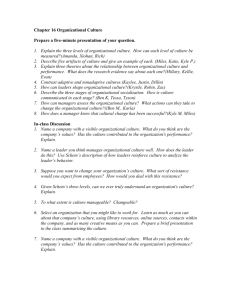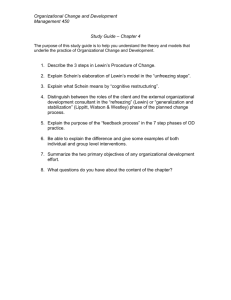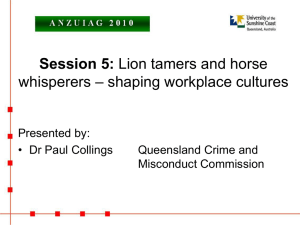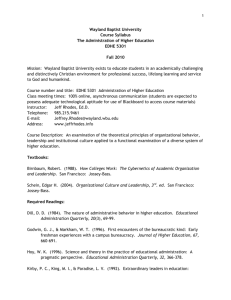Open 100423-Schein_1999_Process_consulting
advertisement
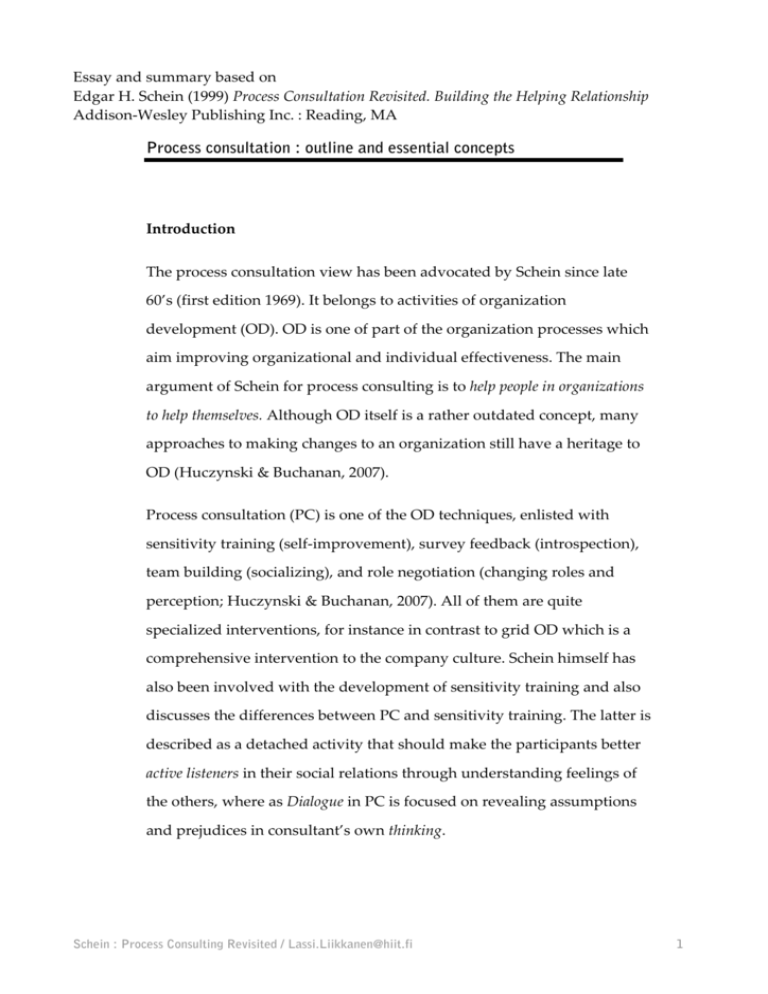
Essay and summary based on Edgar H. Schein (1999) Process Consultation Revisited. Building the Helping Relationship Addison‐Wesley Publishing Inc. : Reading, MA Process consultation : outline and essential concepts Introduction The process consultation view has been advocated by Schein since late 60’s (first edition 1969). It belongs to activities of organization development (OD). OD is one of part of the organization processes which aim improving organizational and individual effectiveness. The main argument of Schein for process consulting is to help people in organizations to help themselves. Although OD itself is a rather outdated concept, many approaches to making changes to an organization still have a heritage to OD (Huczynski & Buchanan, 2007). Process consultation (PC) is one of the OD techniques, enlisted with sensitivity training (self‐improvement), survey feedback (introspection), team building (socializing), and role negotiation (changing roles and perception; Huczynski & Buchanan, 2007). All of them are quite specialized interventions, for instance in contrast to grid OD which is a comprehensive intervention to the company culture. Schein himself has also been involved with the development of sensitivity training and also discusses the differences between PC and sensitivity training. The latter is described as a detached activity that should make the participants better active listeners in their social relations through understanding feelings of the others, where as Dialogue in PC is focused on revealing assumptions and prejudices in consultant’s own thinking. Schein : Process Consulting Revisited / Lassi.Liikkanen@hiit.fi 1 Process Consulting approach Before putting dialogue or other PC methods to their proper context, I need to introduce the consulting framework used in the book. Schein defines process consulting as a consulting model distinct from expert (information purchase) and patient‐doctor models. He acknowledges that the different models do have they value in certain cases, but he still prefers to embed them in a PC framework in order to avoid the evident pitfalls associated with these two “expert‐driven” approaches. PC is described as putting the focus on the client. By understanding that the consultant can only help the clients to solve their problems consultation becomes a matter of establishing a supportive relationship in which the client comes understand the need and opportunities for change. The PC model can also be understood through the list of ten major principles of the model, which can further help to understand the philosophical stance of this approach: 1. 2. 3. 4. 5. 6. 7. 8. 9. 10. Always try to be helpful Always stay in touch with the current reality Access your ignorance All acts are interventions Client owns the problem and the solution Go with the flow Timing is crucial Be constructively opportunistic with confrontive interventions Everything is data; your own errors particularly When in doubt, share the problem Schein’s contribution is a clearly departure from a rationalist, or objective, consulting thinking where one might conceive the consultant as a guru always capable of utilizing a novel insight to successfully crack problems. This is evident in almost all principles, particularly in 3, 9 and 10. The Schein : Process Consulting Revisited / Lassi.Liikkanen@hiit.fi 2 consultant can err but this risk should be minimized if the principles of PC are adhered to as they are aimed to working towards the right solution steadily. PC reminds resistance without violence, a consultant may do the job best by just by suspending all reaction (avoid “doctor’s prescription”) and letting the client self‐reflect on the question. This path can be achieved by following different methods of inquiry. Already mentioned Dialogue is one form of inquiry essential to PC, associated with diagnostic inquiry level of carrying out inquiry. Dialogue is concerned with listening to and understanding yourself (in relation to others) before trying to understand what others mean. Schein also introduces two other forms of inquiry, pure and confrontive inquiry. Each level has its characteristic level of consultant intervening through his or her own opinions, from pure (minimal) to confrontive (considerable). Diagnostic falls between these two, being a level at which the consultant can present neutral questions, in contrast to making suggestion (confrontive) or letting the client do the talking (pure). Social psychology of social relationships and interaction Beyond admitting that a consultant can only deliver subjective truths, the main message from the book is that in order to create this relationship, you need to understand how the relationships work. For this end, Schein introduces a mixture of organizational and social theory, each reflected on different aspect of PC. In this essay, I will consider few of the essential frameworks that Schein uses although they are not originally his ideas; he has just included them as important components of PC. In overall, his books goes through a variety of topics and introduces numerous concept to describe, for instance, different types of consultation clients, group Schein : Process Consulting Revisited / Lassi.Liikkanen@hiit.fi 3 problem solving process, essentials of face‐to‐face communication and the outline of group formation. Before going to the details, it must be acknowledged that the author stresses that things are never as simple as they might look at the first sight. This is because our perception of the world, people and relationships are always biased and our knowledge is inadequate. Schein uses concepts from many schools of psychology, including psychodynamic and Gestalt, to illustrate this point but the main argument is acceptable from any humanist perspective. People are not identical and thus they perceive, understand and behave differently than others. There are several concepts in the text which further illustrate this fact of life. I will consider OJRI cycle and the Johari window here as examples of how our perception and thought is always compromised. Perception ORJI cycle describing the psychological (“intrapsychic”) process of how we become aware of social events in our environment. For a consultant, it is important to have awareness of why we react to and make inferences from the environment in the way we do. The cycle is illustrated below: O Observation R Emotional reaction I Interpretation J Judgment Normally biased process Exaggerated process Schein : Process Consulting Revisited / Lassi.Liikkanen@hiit.fi 4 Schein describes each phase of the perception‐action –cycle through idealistic and realistic terms. Idealistic refers to a rational account of how we may think things could work where as realistic describes the psychological reality which is far from ideal or objective. The disparity of the reality from the ideal creates so called traps, which may lead the consultant to take a wrong way of action. The model begins from observation. In the realistic account, prejudgments, expectations, defenses or false attributions can easily lead to perceptions that wrong in the first place. These biases derive from our cultural background which contains many unspoken assumption, personal defensive filters and expectations derived from past experiences. This might also described by contemporary psychological terms, referring to top‐down influences on perception in contrast to bottom‐up signal processing. Emotional reactions are necessarily subjective and should be talked as inappropriate emotional reactions. This can be due to misperception of a situation (“I think I saw cross the red light”) or learned over reaction to real data (“cars are usually parked here illegally”). Since reactions are quite derivative of observation, Schein recommends that observer him or herself with the help of others to understand how one perceives the environment. To recognize own reaction tendencies can help to relieve them. Judgments may base on faulty logic or false data. Perfect logic is not helpful if the premises, based on observations, are faulty. Cultural assumptions are a big part in judgments and they should be recognized. Communication These prerequisites of intervening, or consulting, present only a part of the Schein : Process Consulting Revisited / Lassi.Liikkanen@hiit.fi 5 whole process. As noted, they are intrapsychical where as the core of the practice is interpsychical process and communication. Similar traps or challenges in communication can be described with terms of The Johari Window (Luft, 1961). The window model is depicted in the figure below: Known to self Hidden self Unknown to others Unknown self Open self Blind self Known to others Unknown to self The main thesis embedded in the Johari Window is that communication involves much more than the primary channel and message. What we say, may not be what we mean. Or we may be intentionally saying something that contradicts what we really think. This would be difference between hidden and open self, parts that are known to us. However, the effectiveness of communication also depends on our blind self, which commonly is communicated through non‐verbal cues but also tones of voice, style of expression and so forth. This part of us is what becomes known to others. As said, we remain blind to some parts that others do perceive, but the Johari window also embeds a Freudian assumption that there are parts of unknown self that remain unknown for everyone. In my view, these might map id or subconscious process operating in our mind, although I remain skeptic whether they really have a role play in the communication scheme. Schein : Process Consulting Revisited / Lassi.Liikkanen@hiit.fi 6 Interpersonal process : feedback As final example of Schein, I have picked a detailed account of one interpersonal process. This is feedback, an everyday mechanism that is elegantly analyzed by the author. Feedback is a mandatory part of the consultation process, as it provides an answer to the fundamental OD question, “how are we doing?”. Generally, two main types of feedback are identified: generic and specific feedback. In all circumstances, the specific feedback should be preferred, because it provides the recipient best opportunities for development. Both can be further analyzed according to their valence, positive, negative or neutral. Examples of different types of feedback are illustrated in the following table: \ Type Valence\ Positive Generic (disposition/trait) You’re awesome, great! Neutral This is like what you I recommend you usually do, keep it up. preview your report always twice before submission. Negative You don’t have what it takes, you always mess it up Specific (behavioral) Yesterday, the ending of the presentation was magnificent! Your talk had a far too long introduction, you should have considered the audience. To further improve feedback, the following rules are suggested: 1. 2. 3. 4. 5. 6. 7. Clear, agreed goals Description and appreciation Concrete and specific Constructive motives, Include negative feedback when necessary Giver provides personal feelings Timing Both parties psychologically ready, Schein : Process Consulting Revisited / Lassi.Liikkanen@hiit.fi 7 Concluding words PC puts a lot of requirements for the consultant. In Schein’s view, good consulting relations require appropriate personality and person relations. The helping relationship is a psychological contract between two or more people, requiring the commitment from all parties. Huczynski & Buchanan (2007) state: “OD consultant requires a range of skills and knowledge, concern with the process, particularly with social and interpersonal skills such as communicating, negotiating and influencing and conflict resolution” Reading some criticism between the lines, I too remain skeptic on whether the helping attitude and wealth of interpersonal required by PC can be acquired with the text and exercises provided by Schein. Although the author actually takes up the issue on his final remarks, in reality it is unknown how much has his own tacit know‐how or giftedness in inter‐ personal intelligence helped him to succeed, past the direction of the then principles of PC (as Schein wants the reader to believe). However, I am convinced that PC thinking should generally be a healthy attitude for preventing the need for similar consultation to arise in organizations. As such, the book provides plenty of insights from sociology and social psychology, which may open up very perspectives into understanding social relations and activity in every unit. Schein : Process Consulting Revisited / Lassi.Liikkanen@hiit.fi 8
